Related Research Articles
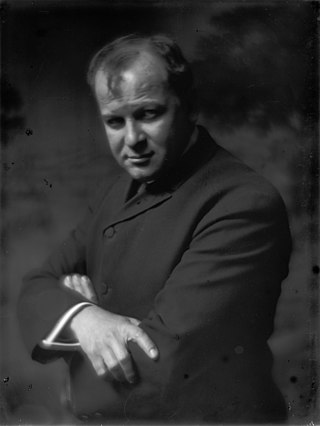
George Benjamin Luks was an American artist, identified with the aggressively realistic Ashcan School of American painting.

Theodore Robinson was an American painter best known for his Impressionist landscapes. He was one of the first American artists to take up Impressionism in the late 1880s, visiting Giverny and developing a close friendship with Claude Monet. Several of his works are considered masterpieces of American Impressionism.
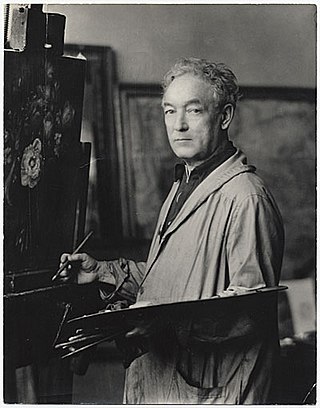
William James Glackens was an American realist painter and one of the founders of the Ashcan School, which rejected the formal boundaries of artistic beauty laid-down by the conservative National Academy of Design. He is also known for his work in helping Albert C. Barnes to acquire the European paintings that form the nucleus of the famed Barnes Foundation in Philadelphia. His dark-hued, vibrantly painted street scenes and depictions of daily life in pre-WW I New York and Paris first established his reputation as a major artist. His later work was brighter in tone and showed the strong influence of Renoir. During much of his career as a painter, Glackens also worked as an illustrator for newspapers and magazines in Philadelphia and New York City.
Philip Martin Pearlstein was an American painter best known for Modernist Realist nudes. Cited by critics as the preeminent figure painter of the 1960s to 2000s, he led a revival in realist art.

Eric Fischl is an American painter, sculptor, printmaker, draughtsman and educator. He is known for his paintings depicting American suburbia from the 1970s and 1980s.

Everett Shinn was an American painter and member of the urban realist Ashcan School.
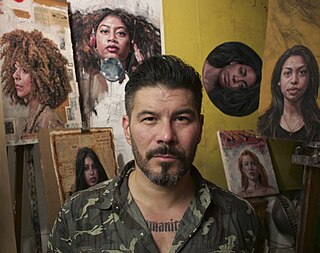
Tim Okamura is a Japanese Canadian artist known for his contemporary realist portraits that combine graffiti and realism. His work has been on the cover of Time Magazine and has been featured in several major motion pictures. Okamura's paintings are featured in major permanent collections around the world such as London's National Portrait Gallery and Washington DC's National Portrait Gallery. He was also one of several artists to be shortlisted in 2006 for a proposed portrait of Queen Elizabeth of England.
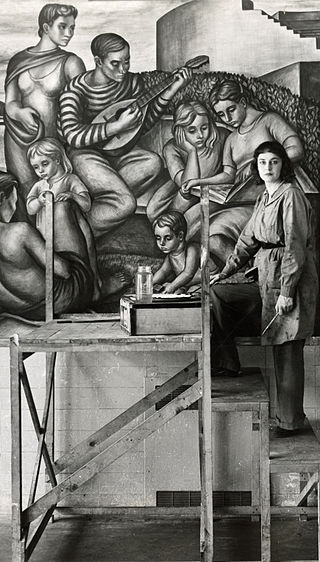
Marion Greenwood was an American social realist artist who became popular starting in the 1920s and became renowned in both the United States and Mexico. She is most well known for her murals, but she also practiced easel painting, printmaking, and frescoes.
Edward (Ed) Clark was an abstract expressionist painter known for his broad, powerful brushstrokes, radiant colors and large-scale canvases. An African-American, he wasn’t widely recognized as a major modernist until relatively late in a seven-decade career, during which he pioneered the use of shaped canvases and of the everyday push broom to create striking works of art.

Frederick J. Brown was a New York City based visual artist originally from Chicago. His style ranges from abstract expressionism to figurative. His art work was influenced by historical, religious, narrative and urban themes. He is noted for his extensive portrait series of jazz and blues musicians.
Tully Filmus was an American realist painter.
Miklos Suba was a Hungarian-born American artist. Trained as an architect, he devoted his time to both architecture and art until 1940 when he dedicated the remainder of his life to painting subject matter in Brooklyn, New York. He is classified as a member of the precisionism movement.
Andrew Guenther is an American artist based in Brooklyn, New York. He received his BFA from Lawrence University in 1998 and his MFA from Rutgers University in 2000. His works have been widely exhibited in the United States, Europe, and Asia.
Walter Henry "Jack" Beal Jr. was an American realist painter.

Agnes Weinrich (1873–1946) was an American visual artist. In the early twentieth century, she played a critical role in introducing cubist theory to American artists, collectors, and the general public and became one of the first American abstractionists. A life-long proponent of modernist art, she was an active participant in the art communities of Provincetown and New York. Early in her career, she traveled widely in Europe and spent extended periods studying in Paris and Berlin. She also studied art in Chicago, Provincetown, and New York. During most of her career, she worked in a Provincetown studio during the warm months and a Manhattan studio during the cold ones. Weinrich's easel work included oil paintings, watercolors, and pastels. She also made block prints and etchings and drew using pencil and crayon. Her paintings, prints, and drawings appeared in solo and group exhibitions throughout her career and she received favorable critical attention both during her life and after her death.
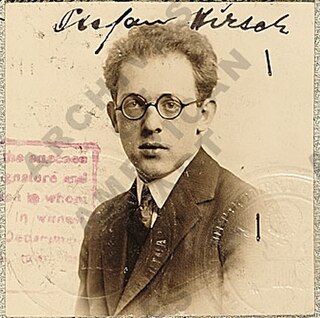
Stefan Hirsch was an American artist. Many of his paintings have the hard edges, smooth surfaces, and simplified forms of the precisionists and their typical subjects—cityscapes and industrial scenes—are sometimes also his, but in general his works have an emotional element and, as one critic as said, "take on an otherworldly tone" that sets them apart. In addition to work showing a personal version of precisionism, he produced paintings, drawings, and prints in the social realist, Mexican muralist, and surrealist styles as well as still lifes, portraits, and landscapes that defy easy classification. His work achieved critical recognition from 1919 onward, has been widely collected, and is today found in many American museums including the Phillips Collection, the Whitney Museum of American Art, the Metropolitan Museum of Art, and the Corcoran Gallery.
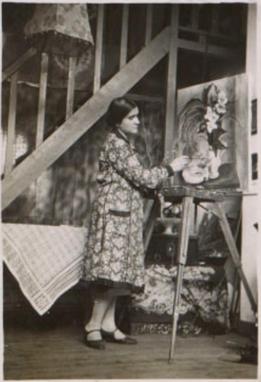
Lena Gurr (1897–1992), was an American artist who made paintings, prints, and drawings showing, as one critic said, "the joys and sorrows of everyday life." Another critic noted that her still lifes, city scenes, and depictions of vacation locales were imbued with "quiet humor," while her portrayal of slum-dwellers and the victims of warfare revealed a "ready sympathy" for victims of social injustice at home and of warfare abroad. During the course of her career Gurr's compositions retained emotional content as they evolved from a naturalistic to a semi-abstract cubist style. Discussing this trend, she once told an interviewer that as her work tended toward increasing abstraction she believed it nonetheless "must have some kind of human depth to it." Born into a Russian-Jewish immigrant family, she was the wife of Joseph Biel, also Russian-Jewish and an artist of similar genre and sensibility.
The Bennett Prize for Women Figurative Realists is a $50,000 biennial art prize established in 2016 by American art collectors Steven Alan Bennett and Dr. Elaine Melotti Schmidt.

Dorothy Eisner (1906–1984) was an American artist whose painting style evolved over many years from an early, quite personal, version of 1930s social realism, through a period of abstract expressionism, and culminating over the last twenty years of her life in a bright painterly style that critics saw as fluid, masterfully composed, and expressionistic. Throughout her long career Eisner maintained a consistency that a gallerist summarized as derived from European modernism but also grounded in American painting of her own generation and the generation before her. Born and raised in Manhattan, she traveled widely and is best known for the late work she made while staying in a summer home off the coast of Maine on Great Cranberry Island.
References
- ↑ "On View: the Hubris of Our Metropolis - July 20, 2006 - The New York Sun". Nysun.com. 2006-07-20. Retrieved 2011-02-01.
- ↑ "SUMMER ARTS PREVIEW / Art / Stark, Dark And Light". Pqasb.pqarchiver.com. Retrieved 2011-02-01.
- ↑ Harrison, Helen A. (12 September 2004). "ART REVIEWS - Of Marshes, Coastal Inlets And Zippers Buried in Latex". New York Times. Retrieved 2011-02-01.
- ↑ Pearse, Emma (2008-09-18). "Artist Derek Buckner on Painting Marshmallows - Vulture". Nymag.com. Retrieved 2011-02-01.